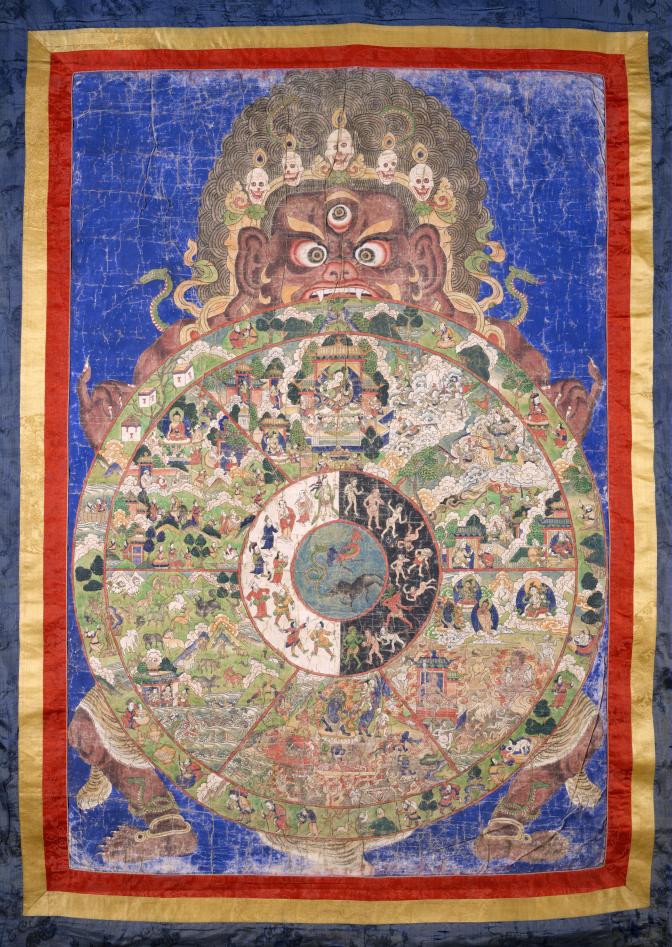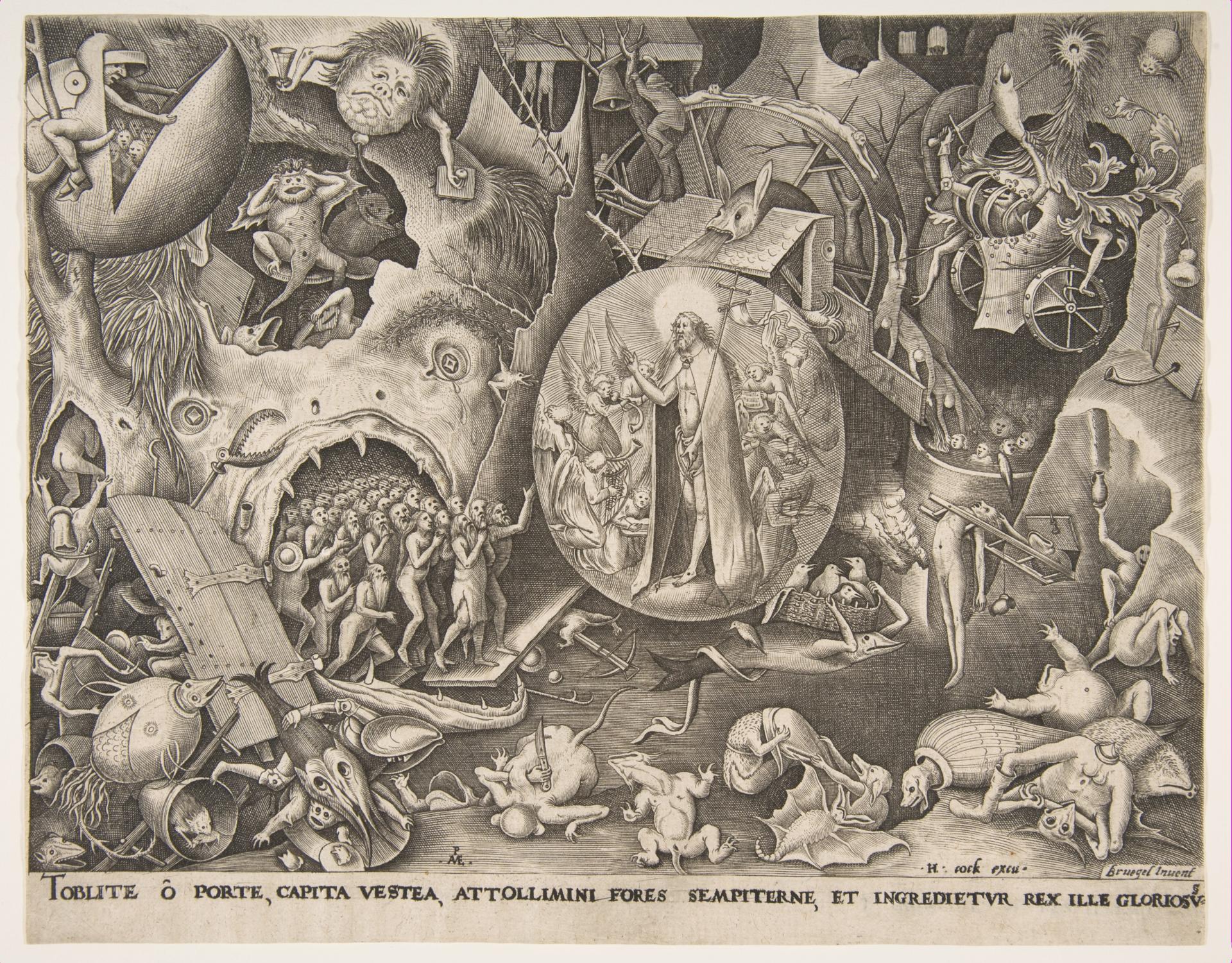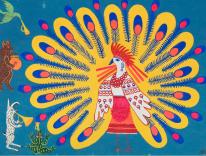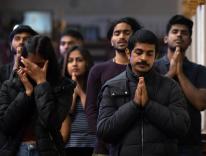Interested in discussing this article in your classroom, parish, reading group, or Commonweal Local Community? Click here for a free discussion guide.
Growing up, I learned to approach death and the afterlife not with dread but with a sense of excitement. Every April, my extended family—like many throughout the Chinese diaspora—observed the Confucian holiday of Tomb Sweeping Day. We would gather at Green-Wood Cemetery in Brooklyn to visit the graves of my paternal grandfather and several other relatives. First, we’d tidy up the greenery around their tombstones, add fresh flowers, and lay out elaborate picnics of food and wine above their graves. Then, we’d burn incense sticks and spirit money so they could buy items they’d need in heaven. A whole roasted pig was also part of the picnic offerings. It’s a common practice of this tradition, one we still observe to this day.
No matter where it’s celebrated, Tomb Sweeping Day is a joyous, festive occasion, not at all somber. Children laugh as they chase each other around the graves. Adults share stories about their departed loved ones while eating their fill of tasty dishes. The food and flowers and incense are offerings to the dead, but so are the laughter and conviviality among those gathered. They are channels through which those buried beneath are reintegrated into the community above.
Death Is Not the End, on view at New York City’s Rubin Museum until January 14, 2024, is also a kind of offering, gently inviting visitors to ponder their ambivalence surrounding this ineluctable feature of human existence. The show gathers fifty-eight works of Tibetan Buddhist and European Christian art from across twelve centuries, gracefully illuminating how the two religions understand death and the afterlife. (As a cross-cultural religious person, the show felt deeply personal to me; I am Christian, my parents are Buddhist, and together we observe many traditions of Chinese folk religion, which draws from Taoism, Confucianism, and Buddhism.) Instead of dwelling on differences, curator Elena Pakhoutova has thoughtfully organized these beautiful prints, paintings, and ritual objects around three major themes that the two religions hold in common. There’s “The Human Condition,” which emphasizes the inevitability of mortality that awaits all living beings; “States In-Between,” addressing ideas of purgatory, limbo, and the bardo; and “(After)-life,” centered on images of resurrection, transformation, and heaven.

Circle and orb motifs recur throughout the show, visually linking many of the works on view. One of the most magisterial appears in Wheel of Life, a nineteenth-century Buddhist scroll painting featuring Yama, the Lord of Death. For those new to Buddhism, this allegorical work is an indispensable pictorial guide to one of its central ideas: reincarnation. Here Yama’s appearance is imposing as he stares directly out at viewers with three bulging eyes. His head is piled high with spiraling locks and crowned with a garland of skulls. A tiger-skin garment drapes down his thighs while gold circlets adorn his ears and ankles. Green serpents writhe around his shoulders and shins.
Yet Yama is quite literally eclipsed by the enormous round disk that he lifts with his taloned fingers. This is the titular Wheel of Life, a representation of the Buddhist belief in samsara, the repetitive cycle of birth, death, and rebirth that all living things must undergo. From the central hub to the outer rim, the wheel is divided into four circular sections illustrating the myriad figures, realms, and states of consciousness that propel the wheel’s rotation. At the center of the wheel we find three symbolic animals. The pig, snake, and rooster represent ignorance, anger, and desire—what Buddhism understands as the three root causes of suffering. Beyond this central hub lies a bisected black-and-white circle featuring a parade of human figures performing a spectrum of virtuous and non-virtuous actions. According to Buddhist belief, each living being’s karma—the sum total of actions in the present and previous lifetimes—can determine the status of their next rebirth.
The next section of the wheel is the widest and most densely illustrated. It features deities, humans, and animals inhabiting six different landscapes. Some of the landscapes are filled with thick clouds or frothy waves. Others are populated by architecture or verdant trees and mountains. This ring represents the six realms into which a living being can be reborn: the realm of gods, demigods, humans, animals, hungry ghosts, and hell. Finally, the wheel’s outer rim depicts human figures in the process of being reborn. The whole thing is punctured by Yama’s sharp fangs—a mordant reminder that all existence is conditioned by death.
A similar circle motif appears in Pieter van der Heyden’s 1561 engraving of The Descent of Christ into Limbo. Here Christ appears to float within a luminous orb as he enters the underworld to save the souls trapped there. The bubble acts as a kind of pure, protective shield against the horde of fantastical creatures and grotesque mechanisms occupying this crowded, chaotic realm. Visually, Christ’s orb echoes the circular mandalas, or divine abodes, that house the All-Knowing Buddha in a series of paintings belonging to the Sarvavid Album (eighteenth to nineteenth century). In one of these, “Liberation from Hell,” the Buddha sits cross-legged in a golden sphere surrounded by clouds. From his hand emanates a trail of white light that reaches down into hell, freeing the deceased from unfortunate rebirths.

Perhaps unsurprisingly, skeletal imagery is also ubiquitous throughout Death Is Not the End. One of the most striking examples is a carved ivory miniature of German or Netherlandish origin that takes the form of a worm-ridden skull (1500–1550). Originally, this macabre sculpture functioned as a memento mori and prayer bead. Those who held this object in their hands and traced its many bumps and crevices with their fingers would have been reminded of the material reality and eventual decay of their own mortal bodies. Nestled in prayerful palms, this sculpture likely compelled believers to reflect on—and perhaps revise—their decisions and actions in life.
Skeletons likewise appear frequently in Buddhist art, but with a radically different emphasis from their Christian counterparts. Here, they appear most frequently as Smashana Adipati, Lords of the Charnel Grounds. According to Buddhist traditions, Smashana Adipati inhabit cremation grounds and perform rapturous, joyful dances among the dead bodies. In two paintings, as well as in a terracotta sculpture and carved wooden table (eighteenth to nineteenth centuries), Smashana Adipati don garlands of skulls and wear colorful accessories around their heads and bodies. Their arms and legs are intertwined as they shake and romp in harmony. Surrounded by flames, they celebrate liberation from attachment to self and body. More important, though, is the fact that they dance and celebrate on behalf of the dead, not against them. Like members of my family on Tomb Sweeping Day, here the Smashana Adipati are helpers.
In a practice called chod (“cutting the ego”), Buddhists visit cremation grounds to meditate, recite verses, and invoke blessings on behalf of the dead. Sometimes they wear or use ritual implements made of bone—aprons, crowns, bracelets, drums, trumpets—to aid their practice. The practitioners engage in these rituals to ensure good rebirths for the dead, to liberate those who are trapped in hell, or to aid them through the bardo, the intermediate realm where each dead being’s consciousness resides while awaiting rebirth.
At the end of the exhibit there’s an interactive station where visitors are encouraged to perform a little ritual of their own. Prompts at a small table with chairs, pencils, and cards invite responses to the following questions: Tell us how death might not be the end. What is rebirth to you? Describe your perfect afterlife. How does believing—or not believing—in the afterlife impact how you live? Museum staff then pin up the cards along clotheslines against the wall so that others can read the responses.
Although I don’t personally know any of the visitors who replied to the prompts, I enjoyed reading their responses and felt a bond with them by virtue of sharing in the same discussion. Too often, if and when we acknowledge death at all, we think of it in strictly negative terms. That’s not to dismiss the grief of loss, or the tragic finality of mortality. But our culture exhibits an increasingly pathological insistence on living forever, heedless of any and all restraints—just think of the compulsive consumerism championed by Jeff Bezos, or the techno-utopianism propagated by Mark Zuckerberg and Elon Musk. It’s not difficult to see how it all might come crashing down.
Such resistant attitudes toward death are not just unsustainable. They also rob us of opportunities to cultivate compassion and solidarity, to hold attitudes and perform actions rooted in the recognition of our common vulnerabilities and limitations. The never-ending extension and maximization of life for its own sake actually leaves us with a much poorer version of human life—one in which mutual care, interdependence, and communion have been squeezed out and shunted aside.
Both Christianity and Buddhism, the Rubin show reminds us, have abundant resources for thinking more fruitfully and holistically about death. All the more so when they partner together instead of remaining siloed off from each other. There’s a reason both make ample use of the circle, a shape that symbolizes continuity and connection. It’s true that one day, we are all going to die. But we need not assume that we go through death alone, or that it gets the last word.
Please email comments to [email protected] and join the conversation on our Facebook page.
Previous Story
How Not to Defend Liberalism
Next Story
Matthew Boudway Interviews George Scialabba at Book Release Event

